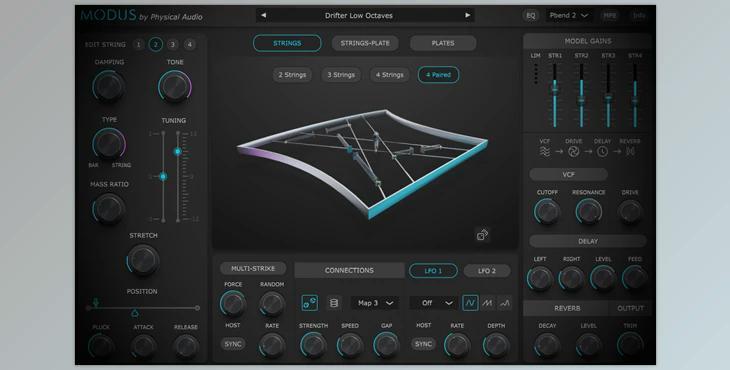
Physical Audio Modus v1.3.1: Embark on an auditory odyssey where the realms of rigorous physics seamlessly intertwine with the fluidity of soft synth processing. Welcome to Modus, a virtual universe of conceptual instruments meticulously crafted with cutting-edge physical behaviors and acoustic properties.
In this unreal sonic landscape, Modus employs our latest breakthroughs in collision modeling, bringing together acoustic elements like strings, plates, springs, and rattles. These elements collide, quite literally, in an algorithmic airspace, generating tones that resonate and react authentically, mirroring their real-world counterparts. Three distinct types of instruments emerge from this convergence.
Connected Strings:
Each voice boasts up to four connected strings, capable of being plucked or serving as resonators. Rattles and nonlinear springs link the strings, offering collision effects as they vibrate. Physical parameters such as decay, mass, and harmonic content, along with semitone and fine-tuning controls, provide a nuanced level of control.
Strings Connected to a Plate:
This model features two strings linked to a plate through nonlinear connections, whether rattles or springs. The strings dynamically retune on the fly, delivering a vast range of monophonic or duophonic sounds spanning six octaves. The plate, acting as a soundboard, allows real-time adjustments to decay, mass, fundamental frequency, and connection controls.
Driven Plates:
A driver signal ignites the top plate, interconnected to the bottom plate through two nonlinear connections. This driver can take the form of a polyphonic sawtooth sine wave, or a multi-striking hit for percussive effects. Additionally, an option exists to employ a single plate connected to the ground.
In Modus, experience a symphony of innovation, where the boundaries between the tangible and the virtual blur, opening up a realm of limitless sonic exploration.
Highlighted Features: